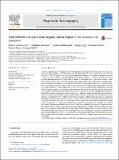Tidal influence on particulate organic carbon export fluxes
Abstract
As tall seamounts may be ‘stepping stones’ for dispersion and migration of deep open ocean fauna, an improved understanding of the productivity at and food supply to such systems needs to be formed. Here, the 234Th/238U approach for tracing settling particulate matter was applied to Senghor Seamount – a tall sub-marine mountain near the tropical Cape Verde archipelago – in order to elucidate the effects of topographically-influenced physical flow regimes on the export flux of particulate organic carbon (POC) from the near-surface (topmost ⩽ 100 m) into deeper waters. The comparison of a suitable reference site and the seamount sites revealed that POC export at the seamount sites was ∼2–4 times higher than at the reference site. For three out of five seamount sites, the calculated POC export fluxes are likely to be underestimates. If this is taken into account, it can be concluded that POC export fluxes increase while the passing waters are advected around and over the seamount, with the highest export fluxes occurring on the downstream side of the seamount. This supports the view that biogeochemical and biological effects of tall seamounts in surface-ocean waters might be strongest at some downstream distance from, rather than centred around, the seamount summit. Based on measured (vessel-mounted ADCP) and modelled (regional flow field: AVISO; internal tides at Senghor: MITgcm) flow dynamics, it is proposed that tidally generated internal waves result in a ‘screen’ of increased rates of energy dissipation that runs across the seamount and leads to a combination of two factors that caused the increased POC export above the seamount: (1) sudden increased upward transport of nutrients into the euphotic zone, driving brief pulses of primary production of new particulate matter, followed by the particles’ export into deeper waters; and (2) pulses of increased shear-driven aggregation of smaller, slower-settling into larger, faster-settling particles. This study shows that, under certain conditions, there can be an effect of a tall seamount on aspects of surface-ocean biogeochemistry, with tidal dynamics playing a prominent role. It is speculated that these effects can control the spatiotemporal distribution of magnitude and nutritional quality of the flux of food particles to the benthic and benthic-pelagic communities at and near tall seamounts.
Citation
Turnewitsch , R , Dumont , M , Kiriakoulakis , K , Megg , S , Mohn , C , Peine , F & Wolff , G 2016 , ' Tidal influence on particulate organic carbon export fluxes ' , Progress in Oceanography , vol. 149 , pp. 189-213 . https://doi.org/10.1016/j.pocean.2016.10.009
Publication
Progress in Oceanography
Status
Peer reviewed
ISSN
0079-6611Type
Journal article
Description
his study was supported through grant NE/G006415/1 of the UK’s Natural Environment Research Council (NERC) and grant 669947 of the European Research Council (ERC).Collections
Items in the St Andrews Research Repository are protected by copyright, with all rights reserved, unless otherwise indicated.

